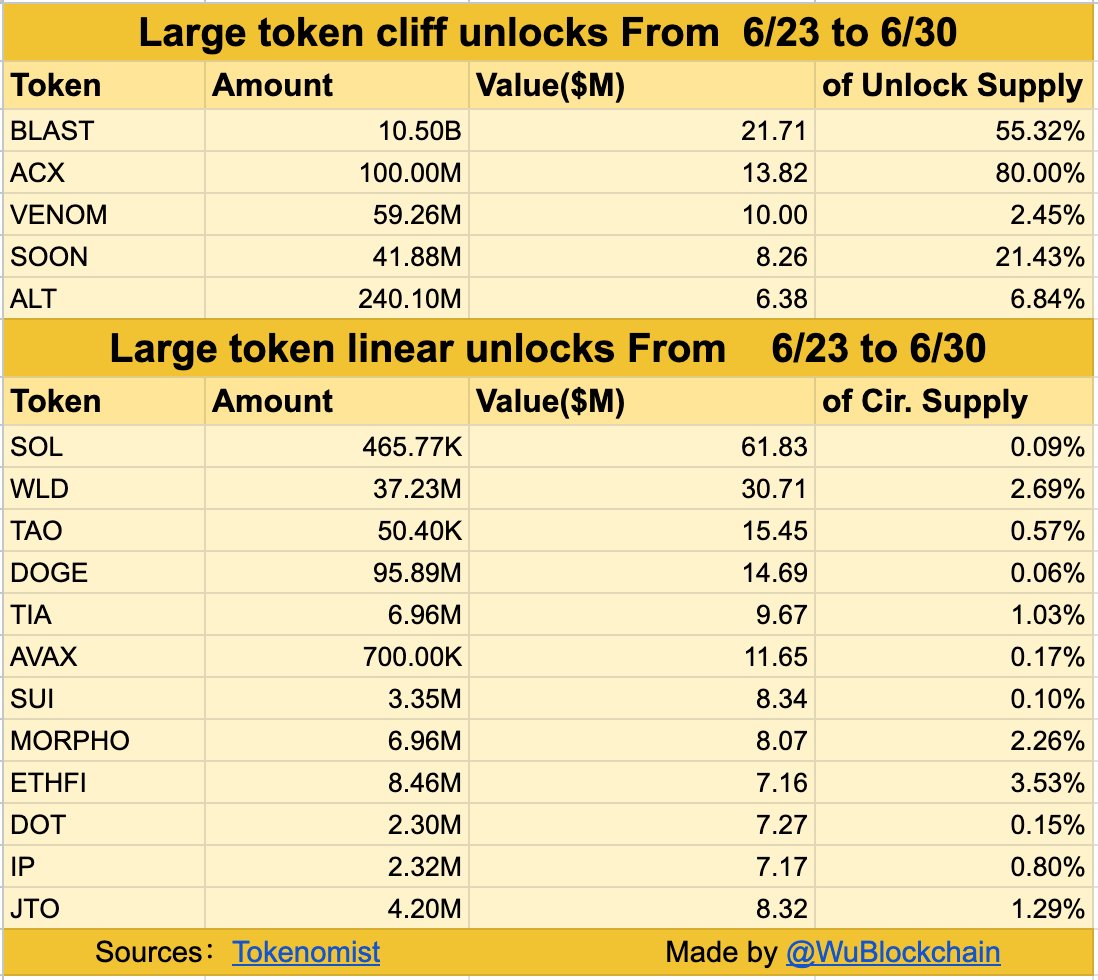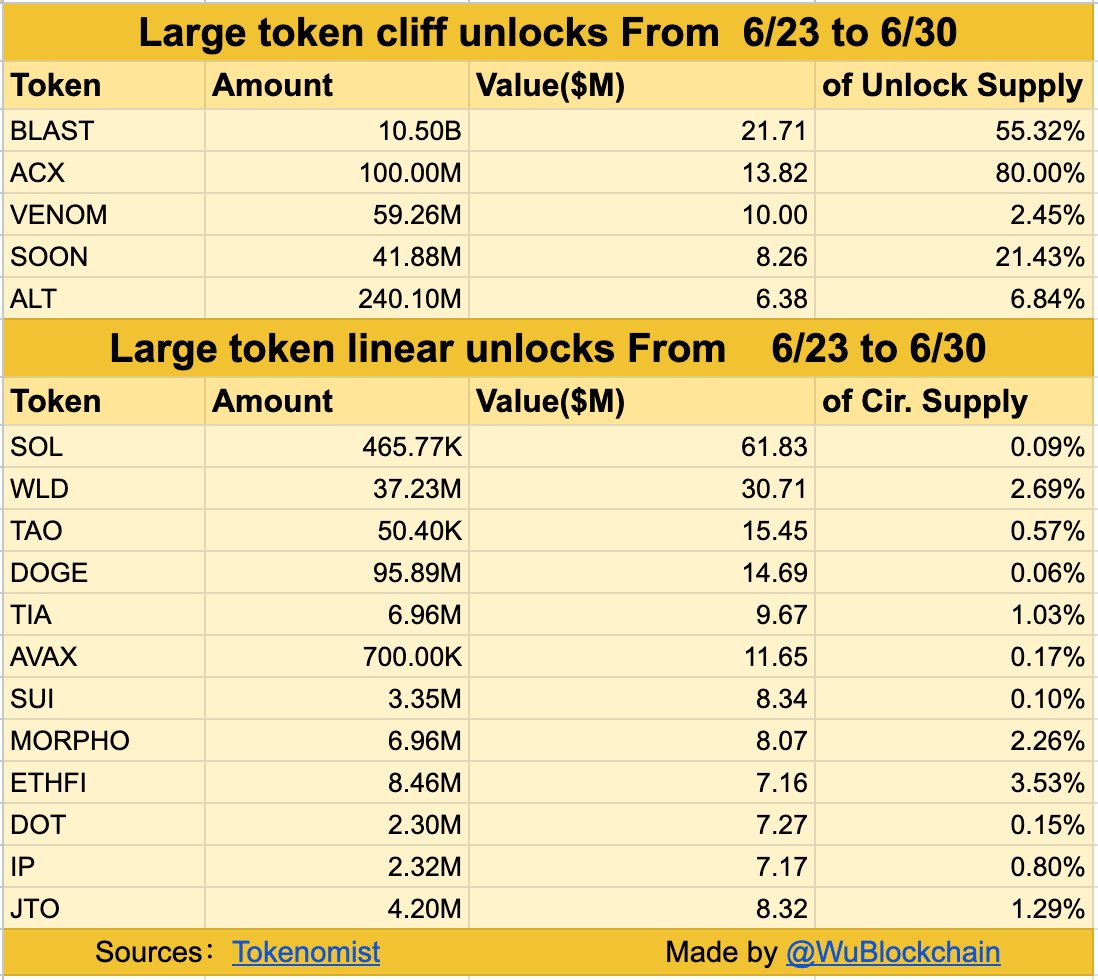
JTO
Jito价格
$1.9920
-$0.08500
(-4.10%)
过去 24 小时的价格变化

免责声明
本页面的社交内容 (包括由 LunarCrush 提供支持的推文和社交统计数据) 均来自第三方,并按“原样”提供,仅供参考。本文内容不代表对任何数字货币或投资的认可或推荐,也未获得欧易授权或撰写,也不代表我们的观点。我们不保证所显示的用户生成内容的准确性或可靠性。本文不应被解释为财务或投资建议。在做出投资决策之前,评估您的投资经验、财务状况、投资目标和风险承受能力并咨询独立财务顾问至关重要。过去的表现并不代表未来的结果。您的投资价值可能会波动,您可能无法收回您投资的金额。您对自己的投资选择自行承担全部责任,我们对因使用本信息而造成的任何损失或损害不承担任何责任。提供外部网站链接是为了用户方便,并不意味着对其内容的认可或控制。
请参阅我们的 使用条款 和 风险警告,了解更多详情。通过使用第三方网站(“第三方网站”),您同意对第三方网站的任何使用均受第三方网站条款的约束和管辖。除非书面明确说明,否则欧易及其关联方(“OKX”)与第三方网站的所有者或运营商没有任何关联。您同意欧易对您使用第三方网站而产生的任何损失、损害和任何其他后果不承担任何责任。请注意,使用第三方网站可能会导致您的资产损失或贬值。本产品可能无法在所有司法管辖区提供或适用。
请参阅我们的 使用条款 和 风险警告,了解更多详情。通过使用第三方网站(“第三方网站”),您同意对第三方网站的任何使用均受第三方网站条款的约束和管辖。除非书面明确说明,否则欧易及其关联方(“OKX”)与第三方网站的所有者或运营商没有任何关联。您同意欧易对您使用第三方网站而产生的任何损失、损害和任何其他后果不承担任何责任。请注意,使用第三方网站可能会导致您的资产损失或贬值。本产品可能无法在所有司法管辖区提供或适用。
Jito 市场信息
市值
市值是通过流通总应量与最新价格相乘进行计算。市值 = 当前流通量 × 最新价
流通总量
目前该代币在市场流通的数量
市值排行
该资产的市值排名
历史最高价
该代币在交易历史中的最高价格
历史最低价
该代币在交易历史中的最低价格
24 小时最高
$2.0820
24 小时最低
$1.9030
历史最高价
$5.3280
-62.62% (-$3.3360)
最后更新日期:2024年4月4日 (UTC+8)
历史最低价
$1.3000
+53.23% (+$0.69200)
最后更新日期:2024年1月8日 (UTC+8)
您认为 JTO 今天会涨还是会跌?
您可以点赞或点踩来表达对该币种今日涨跌的预测
投票并查看结果
Jito 动态资讯
以下内容源自 。

alvin617.eth 🐻⛓️
BTC 最低跌到 98,200 , 目前回彈至 101,250 左右
上週五發的 DeFi 週報... 參考度直接歸零?
不過我的抄底名單還是把 Base 生態給放進來的
當時 Base 榮登週流入第一 , 有 4000 萬美金的流入
值得留意的消息還有摩根大通進軍 Base 發行 JPMD、Virtual 領軍的 ACP 敘事、Creator Bid 加入 ai agent launchpad 之爭等大事 , 也終究敵不過以伊戰爭的歷史性展開
🔸 @cobie 22 日半夜發文詢問除了 $BTC $ETH $SOL $HYPE , 這次市場暴跌還會抄底哪些 token?剛好是個好時機稍微整理一下留言串有哪些有趣答案 👇
🔸 @Auri_0x 提到了$STRK , 與 Solana TPS 競爭的 ETH layer2 , 有著遠比 arb , op 還低的 fdv , 相關敘事還有 , BTC L2 以及
🔸 @0xMert_ Solana 大將軍提到了 JTO , zcash 以及 hSOL
🔸 @blknoiz06 提到了 $WLD , Ansem 認為需要有 infra 來證明誰是人類以及 AI , Worldcoin 很有可能成為這樣子的資料庫 infra
🔸 @jessepollak 提到了 $COIN , 強大且多元化的產品生態 , 該領域執行力最強、最有遠見的鏈上團隊之一 👀
🔸 @Awawat_Trades 表達考慮到時間框架
- PAXG/XAUT 原因顯而易見
- BNB/LEO,上漲空間小,但下跌空間也較小
- AAVE/MKR:不錯的選擇
個人認為目前依然不值得非常樂觀, 不過還是進場抄底了一些自己認為跌不少的幣種
如果還是不敢動作, 那麼資訊減法就是這陣子最應該做的事了

Crypto Wesearch 每日幣研
Base 利多不斷,川普施壓聯準會降息預期升溫 - 0620 幣研週報
🔥【跨鏈淨流入 TOP 1】 @base +4,200 萬
🔥 摩根大通進軍 @base ,JPMD 震撼登場:JPMorgan Chase 在 Base 網路試發行存款代幣 JPMD。Base 生態代幣值得關注,包括 @AerodromeFi 、 @virtuals_io 、 @KaitoAI 、 @GAME_Virtuals 、 @clankeronbase 等。
🔥GENIUS 穩定幣法案火速通過:美國參議院以 68-30 壓倒性票數通過 GENIUS 法案。穩定幣總市值突破 2,500 億美元, @Tether_to 與 @circle 兩強合計市佔達 86%。
💡 內容精選 - 穩定幣:穩定幣與 AI 金融創新 By @Defi0xJeff
【推薦閱讀連結】
credit to @jd950108 @0xfomor
幣研新一期週報,往下看 👇
4.7万
14
USD 兑换 JTO


Jito 价格表现 (美元)
Jito 当前价格为 $1.9920。Jito 的价格在过去 24 小时内下跌了 -4.09%。目前,Jito 市值排名为第 0 名,实时市值为 $6.78亿,流通供应量为 340,107,922 JTO,最大供应量为 1,000,000,000 JTO。我们会实时更新 Jito/USD 的价格。
今日
-$0.08500
-4.10%
7 天
-$0.38400
-16.17%
30 天
-$0.02500
-1.24%
3 个月
-$0.42500
-17.59%
关于 Jito (JTO)
此评级是欧易从不同来源收集的汇总评级,仅供一般参考。欧易不保证评级的质量或准确性。欧易无意提供 (i) 投资建议或推荐;(ii) 购买、出售或持有数字资产的要约或招揽;(iii) 财务、会计、法律或税务建议。包括稳定币和 NFT 的数字资产容易受到市场波动的影响,风险较高,波动较大,可能会贬值甚至变得一文不值。数字资产的价格和性能不受保证,且可能会发生变化,恕不另行通知。您的数字资产不受潜在损失保险的保障。 历史回报并不代表未来回报。欧易不保证任何回报、本金或利息的偿还。欧易不提供投资或资产建议。您应该根据自身的财务状况仔细考虑交易或持有数字资产是否适合您。具体情况请咨询您的专业法务、税务或投资人士。
展开更多
- 官网
- 区块浏览器
关于第三方网站
关于第三方网站
通过使用第三方网站(“第三方网站”),您同意对第三方网站的任何使用均受第三方网站条款的约束和管辖。除非书面明确说明,否则 OKX 及其关联方(“OKX”)与第三方网站的所有者或运营商没有任何关联。您同意 OKX 对您使用第三方网站而产生的任何损失、损害和任何其他后果不承担任何责任。请注意,使用第三方网站可能会导致您的资产损失或贬值。
Jito 常见问题
Jito 今天值多少钱?
目前,一个 Jito 价值是 $1.9920。如果您想要了解 Jito 价格走势与行情洞察,那么这里就是您的最佳选择。在欧易探索最新的 Jito 图表,进行专业交易。
数字货币是什么?
数字货币,例如 Jito 是在称为区块链的公共分类账上运行的数字资产。了解有关欧易上提供的数字货币和代币及其不同属性的更多信息,其中包括实时价格和实时图表。
数字货币是什么时候开始的?
由于 2008 年金融危机,人们对去中心化金融的兴趣激增。比特币作为去中心化网络上的安全数字资产提供了一种新颖的解决方案。从那时起,许多其他代币 (例如 Jito) 也诞生了。
Jito 的价格今天会涨吗?
查看 Jito 价格预测页面,预测未来价格,帮助您设定价格目标。
ESG 披露
ESG (环境、社会和治理) 法规针对数字资产,旨在应对其环境影响 (如高能耗挖矿)、提升透明度,并确保合规的治理实践。使数字代币行业与更广泛的可持续发展和社会目标保持一致。这些法规鼓励遵循相关标准,以降低风险并提高数字资产的可信度。
资产详情
名称
OKcoin Europe LTD
相关法人机构识别编码
54930069NLWEIGLHXU42
代币名称
Jito
共识机制
Solana uses a unique combination of Proof of History (PoH) and Proof of Stake (PoS) to achieve high throughput, low latency, and robust security. Here’s a detailed explanation of how these mechanisms work: Core Concepts 1. Proof of History (PoH): Time-Stamped Transactions: PoH is a cryptographic technique that timestamps transactions, creating a historical record that proves that an event has occurred at a specific moment in time. Verifiable Delay Function: PoH uses a Verifiable Delay Function (VDF) to generate a unique hash that includes the transaction and the time it was processed. This sequence of hashes provides a verifiable order of events, enabling the network to efficiently agree on the sequence of transactions. 2. Proof of Stake (PoS): Validator Selection: Validators are chosen to produce new blocks based on the number of SOL tokens they have staked. The more tokens staked, the higher the chance of being selected to validate transactions and produce new blocks. Delegation: Token holders can delegate their SOL tokens to validators, earning rewards proportional to their stake while enhancing the network's security. Consensus Process 1. Transaction Validation: Transactions are broadcast to the network and collected by validators. Each transaction is validated to ensure it meets the network’s criteria, such as having correct signatures and sufficient funds. 2. PoH Sequence Generation: A validator generates a sequence of hashes using PoH, each containing a timestamp and the previous hash. This process creates a historical record of transactions, establishing a cryptographic clock for the network. 3. Block Production: The network uses PoS to select a leader validator based on their stake. The leader is responsible for bundling the validated transactions into a block. The leader validator uses the PoH sequence to order transactions within the block, ensuring that all transactions are processed in the correct order. 4. Consensus and Finalization: Other validators verify the block produced by the leader validator. They check the correctness of the PoH sequence and validate the transactions within the block. Once the block is verified, it is added to the blockchain. Validators sign off on the block, and it is considered finalized. Security and Economic Incentives 1. Incentives for Validators: Block Rewards: Validators earn rewards for producing and validating blocks. These rewards are distributed in SOL tokens and are proportional to the validator’s stake and performance. Transaction Fees: Validators also earn transaction fees from the transactions included in the blocks they produce. These fees provide an additional incentive for validators to process transactions efficiently. 2. Security: Staking: Validators must stake SOL tokens to participate in the consensus process. This staking acts as collateral, incentivizing validators to act honestly. If a validator behaves maliciously or fails to perform, they risk losing their staked tokens. Delegated Staking: Token holders can delegate their SOL tokens to validators, enhancing network security and decentralization. Delegators share in the rewards and are incentivized to choose reliable validators. 3. Economic Penalties: Slashing: Validators can be penalized for malicious behavior, such as double-signing or producing invalid blocks. This penalty, known as slashing, results in the loss of a portion of the staked tokens, discouraging dishonest actions.
奖励机制与相应费用
Solana uses a combination of Proof of History (PoH) and Proof of Stake (PoS) to secure its network and validate transactions. Here’s a detailed explanation of the incentive mechanisms and applicable fees: Incentive Mechanisms 4. Validators: Staking Rewards: Validators are chosen based on the number of SOL tokens they have staked. They earn rewards for producing and validating blocks, which are distributed in SOL. The more tokens staked, the higher the chances of being selected to validate transactions and produce new blocks. Transaction Fees: Validators earn a portion of the transaction fees paid by users for the transactions they include in the blocks. This provides an additional financial incentive for validators to process transactions efficiently and maintain the network's integrity. 5. Delegators: Delegated Staking: Token holders who do not wish to run a validator node can delegate their SOL tokens to a validator. In return, delegators share in the rewards earned by the validators. This encourages widespread participation in securing the network and ensures decentralization. 6. Economic Security: Slashing: Validators can be penalized for malicious behavior, such as producing invalid blocks or being frequently offline. This penalty, known as slashing, involves the loss of a portion of their staked tokens. Slashing deters dishonest actions and ensures that validators act in the best interest of the network. Opportunity Cost: By staking SOL tokens, validators and delegators lock up their tokens, which could otherwise be used or sold. This opportunity cost incentivizes participants to act honestly to earn rewards and avoid penalties. Fees Applicable on the Solana Blockchain 7. Transaction Fees: Low and Predictable Fees: Solana is designed to handle a high throughput of transactions, which helps keep fees low and predictable. The average transaction fee on Solana is significantly lower compared to other blockchains like Ethereum. Fee Structure: Fees are paid in SOL and are used to compensate validators for the resources they expend to process transactions. This includes computational power and network bandwidth. 8. Rent Fees: State Storage: Solana charges rent fees for storing data on the blockchain. These fees are designed to discourage inefficient use of state storage and encourage developers to clean up unused state. Rent fees help maintain the efficiency and performance of the network. 9. Smart Contract Fees: Execution Costs: Similar to transaction fees, fees for deploying and interacting with smart contracts on Solana are based on the computational resources required. This ensures that users are charged proportionally for the resources they consume.
信息披露时间段的开始日期
2024-06-14
信息披露时间段的结束日期
2025-06-14
能源报告
能源消耗
112.92713 (kWh/a)
能源消耗来源与评估体系
The energy consumption of this asset is aggregated across multiple components:
To determine the energy consumption of a token, the energy consumption of the network(s) solana is calculated first. For the energy consumption of the token, a fraction of the energy consumption of the network is attributed to the token, which is determined based on the activity of the crypto-asset within the network. When calculating the energy consumption, the Functionally Fungible Group Digital Token Identifier (FFG DTI) is used - if available - to determine all implementations of the asset in scope. The mappings are updated regularly, based on data of the Digital Token Identifier Foundation.
USD 兑换 JTO

























社媒平台热度